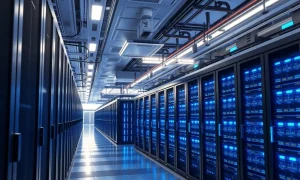The energy sector is witnessing a significant shift. Vistra, a major power producer, reports a remarkable increase in AI and Crypto Electricity Demand. This surge resembles the rapid growth observed in the 1990s. Consequently, power companies are adjusting their forecasts. They prepare for an unprecedented rise in consumption. This trend has far-reaching implications for infrastructure and future energy policy. Businesses and entrepreneurs must understand these dynamics. The energy landscape is evolving quickly.
Vistra’s Forecast: Echoes of the 1990s Growth
Vistra’s recent observations highlight a striking parallel. The current growth in electricity demand mirrors the robust expansion of the 1990s. This era saw significant economic prosperity and technological adoption. Today, artificial intelligence and cryptocurrency operations drive this renewed demand. They require substantial power. Therefore, utilities must adapt quickly. This situation presents both challenges and opportunities. Understanding this historical context helps grasp the current situation.
Vistra, a leading integrated retail electricity and power generation company, provides a unique perspective. Its vast operations span multiple states. The company manages a diverse energy portfolio. This includes natural gas, nuclear, and renewables. Vistra’s insights are thus crucial. They reflect real-time market trends. They also indicate future energy requirements. Furthermore, their predictions influence investment decisions across the sector.
- Increased Load: Data centers and mining operations demand constant, high-volume power.
- Infrastructure Strain: Existing grids face pressure to deliver more electricity reliably.
- Investment Needs: Significant capital is required for new generation and transmission.
The AI Revolution: Fueling AI and Crypto Electricity Demand
Artificial intelligence is transforming industries worldwide. However, this advancement comes with a substantial energy cost. Training large AI models, for instance, consumes vast amounts of electricity. Data centers, the backbone of AI, operate 24/7. They house powerful servers and cooling systems. These systems are incredibly energy-intensive. Consequently, the demand for power from this sector is escalating rapidly. This trend is expected to continue for years.
Consider the scale of AI operations. A single large language model (LLM) can consume as much electricity as several homes during its training phase. As AI becomes more sophisticated, its energy footprint grows. This includes generative AI, machine learning, and complex algorithms. Therefore, energy providers must factor this into their planning. They need to ensure a stable and sufficient power supply. Moreover, the efficiency of AI hardware is a critical concern. Innovations in chip design could help mitigate some of this demand.
Key Aspects of AI Energy Consumption:
- Data Centers: These facilities are major consumers. They run high-performance computing.
- Cooling Systems: Servers generate immense heat. Cooling them requires significant energy.
- Model Training: Developing advanced AI models is computationally expensive.
- Inference: Running trained models for real-world applications also consumes power.
Cryptocurrency’s Role in Surging Energy Needs
Cryptocurrencies, particularly those relying on Proof-of-Work (PoW) mechanisms like Bitcoin, are also major energy consumers. Mining these digital assets involves solving complex computational puzzles. This process requires specialized hardware. These machines run continuously. They consume vast amounts of electricity. Consequently, the global energy consumption of cryptocurrencies has become a significant topic. It sparks debates about sustainability and environmental impact. This contributes directly to the rising AI and Crypto Electricity Demand.
Bitcoin’s energy consumption alone is comparable to that of entire countries. This figure fluctuates with network difficulty and Bitcoin’s price. When prices rise, more miners join the network. This increases overall energy use. Conversely, lower prices can lead to some miners shutting down. However, the overall trend remains upward. As more people adopt cryptocurrencies, the demand for mining capacity grows. This directly translates into higher electricity needs. Furthermore, new mining operations often seek locations with cheap power. This can strain local grids.
Understanding Crypto Energy Demands:
- Proof-of-Work (PoW): This consensus mechanism is highly energy-intensive.
- Mining Hardware: ASICs (Application-Specific Integrated Circuits) are designed for efficiency but still consume significant power.
- Global Distribution: Miners operate worldwide, seeking low-cost electricity.
- Network Security: Energy consumption is tied to the security of PoW networks.
Impact on Energy Infrastructure and Grids
The rapid rise in AI and Crypto Electricity Demand places immense pressure on existing energy infrastructure. Grids must handle unprecedented loads. This requires significant upgrades and expansion. Transmission lines need reinforcement. Distribution networks must become more robust. Moreover, peak demand periods become more challenging to manage. Energy companies face the complex task of balancing supply and demand. They must ensure reliability while meeting surging needs. This situation requires strategic long-term planning.
Power plant capacity must also increase. Building new power plants takes time and capital. Integrating renewable energy sources is a priority. However, their intermittency poses challenges. Storage solutions, like large-scale batteries, are becoming vital. They help stabilize the grid. Furthermore, grid modernization efforts are underway. These include smart grid technologies. They allow for better management and efficiency. Nevertheless, the scale of investment needed is enormous. This impacts consumers through potential rate increases. Regulators also play a key role in facilitating these necessary changes.
Addressing the Growing Energy Challenge
Meeting the escalating AI and Crypto Electricity Demand requires a multi-faceted approach. Energy efficiency improvements are crucial. Data centers can optimize their operations. They can adopt more efficient cooling technologies. Renewable energy integration is another vital strategy. Solar and wind power can provide clean electricity. However, their variable nature demands robust storage solutions. Furthermore, nuclear power is gaining renewed interest. It offers a reliable, carbon-free baseload. Policy decisions will significantly influence these developments.
Innovation in energy storage is accelerating. Battery technology is improving rapidly. This allows for better grid stability. Demand-side management programs can also help. These encourage consumers to shift their energy use. Utilities can incentivize off-peak consumption. Moreover, direct power purchase agreements are becoming common. Large tech companies and crypto miners directly contract with renewable energy producers. This helps fund new clean energy projects. Collaboration between tech giants, energy providers, and policymakers is essential. They must work together to build a sustainable energy future. This complex challenge demands innovative solutions from all stakeholders.
Market Implications and Investment Opportunities
The surge in AI and Crypto Electricity Demand creates significant market implications. Energy companies stand to benefit from increased sales. However, they also face higher capital expenditures. Investors are watching this sector closely. Opportunities exist in power generation, transmission, and energy storage. Companies developing efficient cooling systems for data centers may also see growth. The demand for specialized hardware for AI and crypto is rising. This impacts the semiconductor industry as well. Therefore, the ripple effect extends across various sectors. Analysts are adjusting their long-term forecasts for utility stocks. This growing demand could lead to sustained revenue growth. Furthermore, the push for green energy solutions presents new investment avenues. Companies focused on renewable energy infrastructure are particularly attractive. The energy transition is accelerating due to these new demands.
Governments and regulatory bodies are also responding. They are exploring policies to manage this growth. This includes incentives for renewable energy. They also consider regulations for energy-intensive industries. The goal is to ensure a stable and sustainable energy supply. This dynamic environment offers both risks and rewards for investors. Strategic planning is essential. Understanding the interplay between technology and energy markets is key. The future of energy is being shaped by these powerful forces. This unprecedented demand requires careful management. It will drive significant innovation and investment.
In conclusion, Vistra’s insights underscore a pivotal moment for the energy industry. The escalating AI and Crypto Electricity Demand is not merely a transient spike. Instead, it represents a fundamental shift. This shift echoes past periods of rapid economic expansion. It presents both formidable challenges and substantial opportunities. The ability to meet these growing energy needs will define future technological and economic progress. Therefore, stakeholders across industries must collaborate. They must invest in robust, sustainable energy solutions. This ensures a resilient power grid for the decades ahead.
Frequently Asked Questions (FAQs)
What is driving the current surge in electricity demand?
The primary drivers are the rapid expansion of artificial intelligence (AI) technologies and the continued growth of cryptocurrency mining operations. Both require significant computational power and, consequently, large amounts of electricity.
How does AI consume so much electricity?
AI’s high electricity consumption stems from training complex models in data centers. These facilities house thousands of powerful servers. They also require extensive cooling systems. All these components are highly energy-intensive.
Why are cryptocurrencies energy-intensive?
Many cryptocurrencies, especially Bitcoin, use a Proof-of-Work (PoW) mechanism. This involves competitive computing to validate transactions. Specialized hardware (ASICs) performs these calculations. This process consumes substantial electricity.
What impact does this demand have on the power grid?
Increased demand places significant strain on existing power grids. It necessitates upgrades to transmission and distribution infrastructure. It also requires new power generation capacity. This ensures reliability and prevents blackouts.
What are energy companies doing to address this increased demand?
Energy companies are investing in new generation capacity, including renewables and nuclear. They are also upgrading grid infrastructure. Furthermore, they are exploring energy storage solutions and promoting efficiency measures. This helps manage the growing load.
Will this trend lead to higher electricity prices?
Increased demand and the need for infrastructure investments could potentially lead to higher electricity prices. However, efficiency gains and the development of new, cheaper energy sources could help mitigate some of these costs. Regulatory decisions also play a role.






















